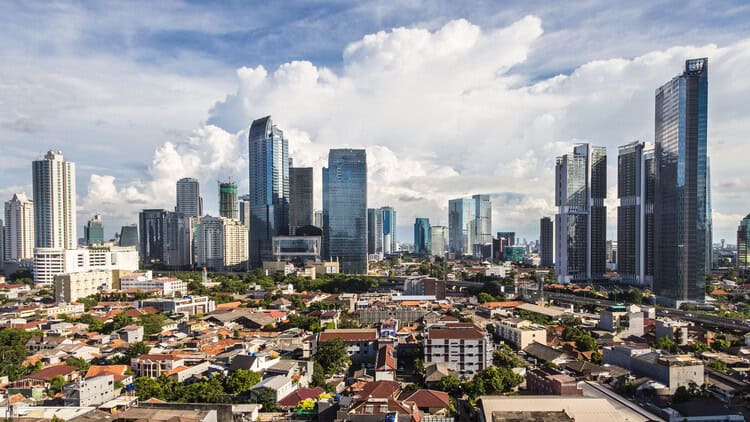Indonesia has experienced significant growth in recent years – so much so that it is building a completely new capital city to alleviate concerns. But
Boasting a population of over 280 million people, Indonesia is the fourth most populated nation in the world. With a gross domestic product (GDP) per capita of $4,788, the Association of Southeast Asian Nations (ASEAN) member, is looking to continue to grow its economy.
According to the World Bank, Indonesia’s gross domestic product growth is forecast to average 5.1 per cent per year from 2024 to 2026. Jakarta, the country’s capital, has experienced significant growth, with its metropolitan area home to around 30 million people. However, this growth in population has come with heavy traffic issues, high levels of pollution, frequent flooding, and drinking water shortages.
To combat this, and the fact that parts of the city are literally sinking, Indonesia has been building a new capital city from scratch, to relocate its capital. Nusantara, the new capital city, aims to alleviate ongoing difficulties in Jakarta and is almost complete.
Positive signs
Key sectors and exports of Indonesia include crude petroleum, natural gas, rubber, coffee, cocoa and palm oil. Indonesia’s startup and fintech scene, are also growing and have strong potential. In 2022, the country housed over 2,400 startups, as well as 120 incubators and accelerators with 200 financing institutions catering to startups; according to the Asian Development Bank.
Indonesia also boasts a high internet penetration rate of 79.5 per cent, with millennials (aged 28 to 43) that figure sits at 93.17 per cent. In 2022, over 80 per cent of the population had smartphones and over 212 million people accessed the internet via mobile devices.
In the same year, the value of e-commerce transactions in Indonesia totalled around $51.9billion, highlighting the promise that fintech can offer the country. It is estimated that the digital economy could add as much as $2.8trillion to the Indonesian economy by 2040.
How is fintech integrating in Indonesia?
As in much of Southeast Asia, QR code payments are popular in Indonesia – by 2021, 39 per cent of Indonesian consumers already used QR codes for payments.
Bank Indonesia, the country’s central bank, requires digital payment services to use standardised QR codes, ensuring all banks and e-wallets are interoperable. Last year, there were approximately 45 million registered merchants, which is almost double that of 2022 (22.4 million merchants), and is the highest in the ASEAN region.
The rise of local digital banks also indicates the influence of fintech on the region. Some of the largest financial institutions in the country have created their own digital banks:
- Bank Raya is owned by Bank Rakyat Indonesia
- BCA Digital is owned by Bank Central Asia
- hibank (formerly Bank Mayora) was acquired by Bank Negara Indonesia
Meanwhile, other standalone digital banks have also established strong roots in Indonesia, including Bank Jago, Superbank and Allobank.
At least 785 fintechs call Indonesia home, the second highest behind Singapore (which is estimated to have 1,600 fintechs). Some of the country’s fintechs include mobile wallets and digital payment platforms GoPay and OVO, as well as wealthtechs Bibit and Ajaib.
Fintech x Islamic finance
Given the majority – around 90 per cent – of the population in the country is Muslim, it is no surprise that Indonesian Islamic finance offerings are enjoying success.
Besides commercial banks, the country also has sharia-compliant institutions and this also applies in fintech. The top six players in this market, accounting for 85 per cent of transaction volume and assets under management, include Saudi Arabia, Iran, Malaysia, the United Arab Emirates (UAE), Indonesia and Kuwait, according to the Global Islamic Fintech Report 2023/2024.
Ecosystem setup
Bank Indonesia oversees monetary policy, while the Indonesian Financial Services Authority (OJK), is responsible for oversight of peer-to-peer (P2P) lending, digital banking, crowdfunding, financial data security, technology in insurance, and financial consumer protection.
In August 2020, the OJK launched the ‘Digital Financial Innovation Roadmap and Action Plan’, which focuses on developing a supportive and comprehensive digital financial ecosystem – enabling the creation of a competitive financial services industry which is fit for the future.
The Authority also launched its ‘Masterplan for the Indonesian Financial Services Sector’ which focused on the financial services sector helping boost economic recovery and development in a post-covid world. It also launched the ‘Indonesian Banking Development Roadmap‘, in a move to strengthen the country’s financial services sector and make it more competitive.
In 2021, Bank Indonesia launched new standards for payment methods, setting the foundation for the development of open banking.
What does the future look like?
While Indonesia’s economy boasts a number of positive signs and is enjoying significant growth, it remains a developing economy. Around half of the country’s population still do not have a bank account, or are underserved by financial services institutions.
Also, much of the economic activity centres around Jakarta, which is reflected in the spread of the financial services infrastructure. For instance, the Indonesian Financial Services Authority says over 60 per cent of bank branches and ATMs are located in Java, while only just over 50 per cent of the Indonesian population reside there.
Nonetheless, Indonesia has a bright future and significant potential, which the fintech ecosystem can help unlock as it continues its economic development and diversification.

